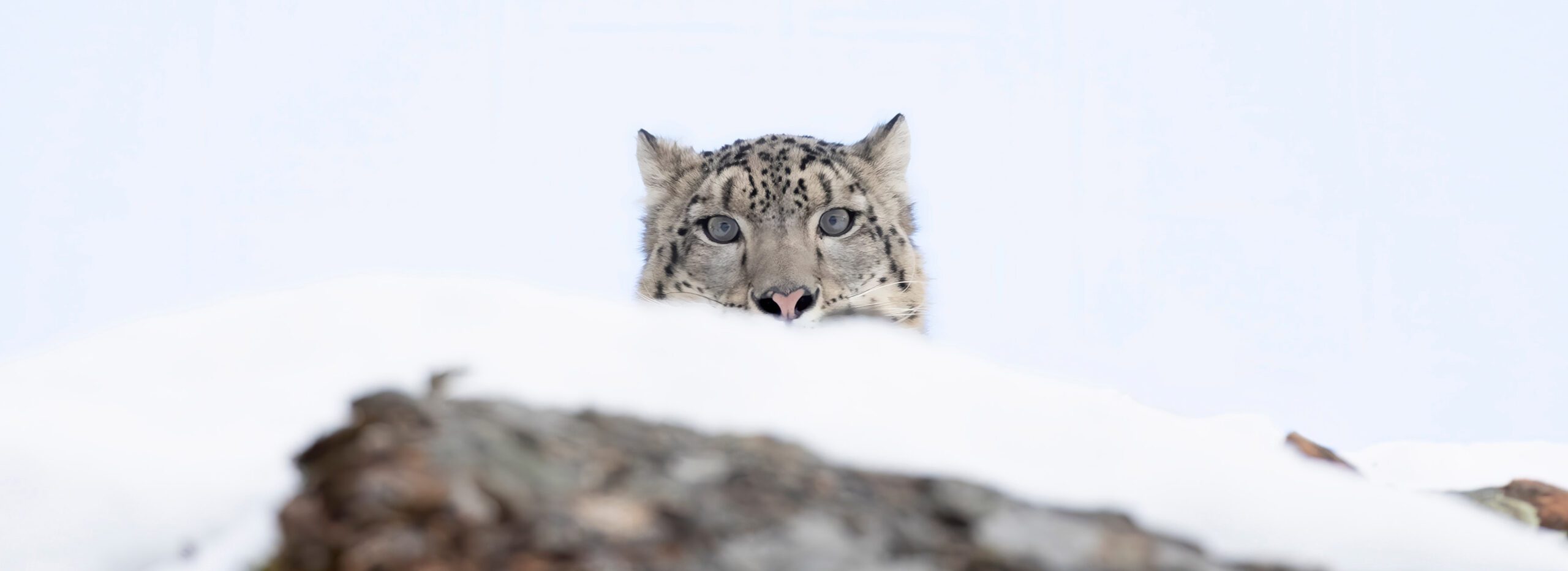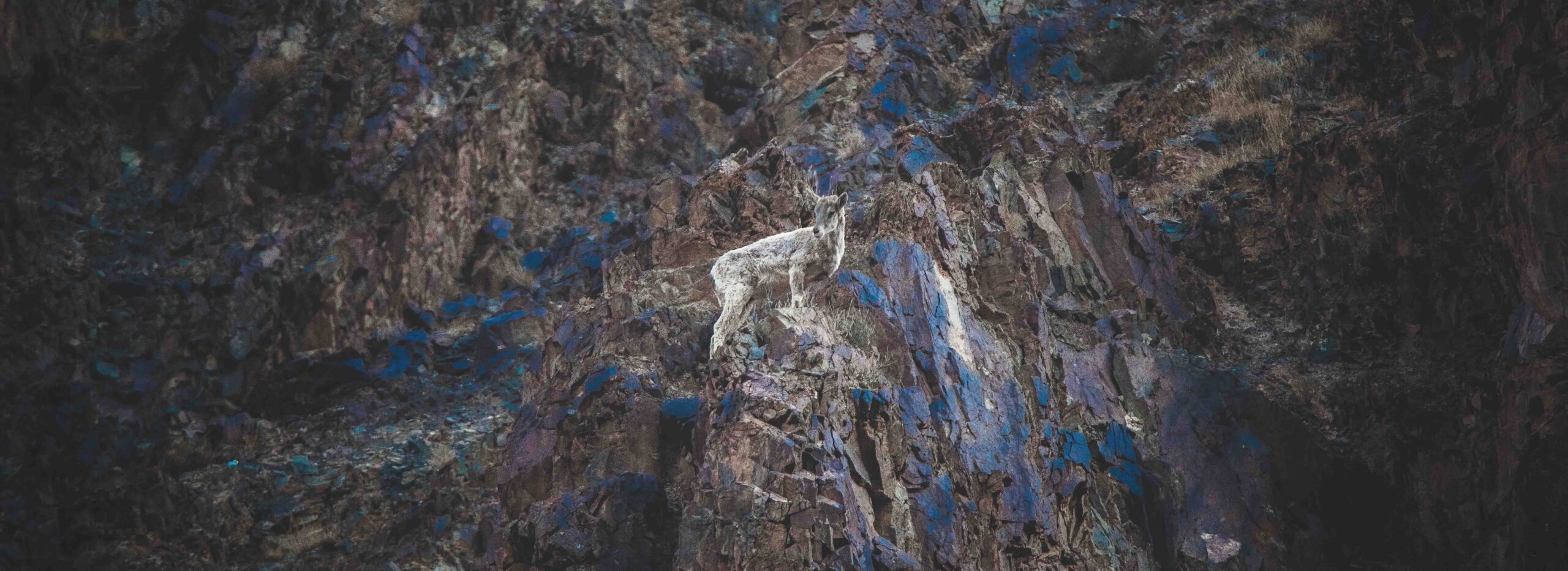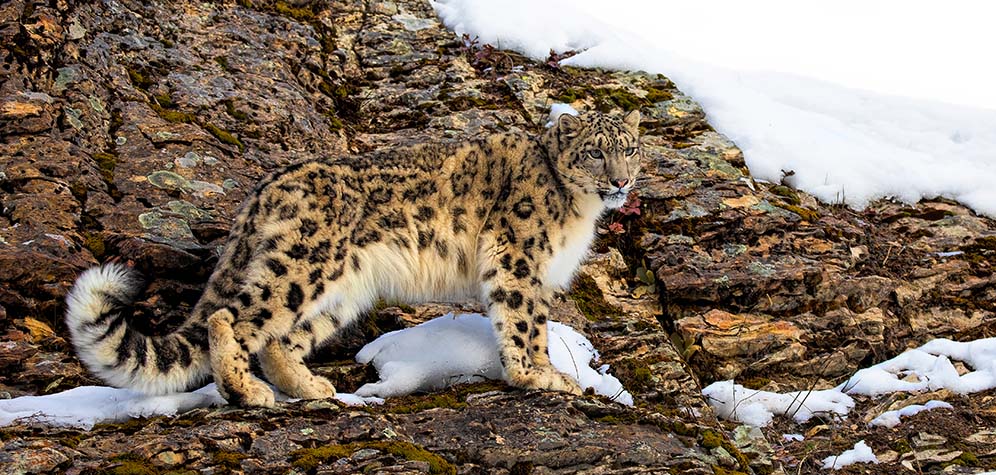





The ideal period for spotting Snow Leopard is from October to March, that’s from the end of Autumn to the Beginning of Spring. These elusive cats are spotted throughout the Hemis National Park, and in the Sham area west of Leh the famous spots are Ney Phu, Ule Phu, and hills of Skindyang village. Snow Leopards are generally found at elevations between 3350-6500m, this epic adventure takes us through stunning Himalayan alpine and sub-alpine zones where vegetation is sparse and temperatures are extreme. Accompanying us are expert local guides whose expertise in this harsh terrain and their intrinsic training to look for the minutest evidence like pugmarks, scrapes, and scats to track this elusive cat is unmatched.
Besides Snow Leopard there is always a good chance of spotting many other famous and rare animals like “Nyan” or “Tinetan Argali”,(Ovis ammon); Himalayan blue sheep, called “Bharal” or “Napo”, (Pseudois nayaur); Uriel, locally called “Shapo” (Ovis orientalis), Asiatic ibex Skin(Capra sibirica), and among the predators are Red Fox, Tibetan Wolf, Lynx, Pallas Cat, and many others. For bird watchers, it’s a dream destination. Besides Golden Eagle, Lammergeier vulture and the Himalayan Griffon vulture, the park is home to Brown Accentor, Robin Accentor, Tickell’s Leaf Warbler, Streaked Rosefinch, Tibetan Snowfinch, Chukar, Fork-tailed Swift, Red-billed Chough, Himalayan Snowcock, and the Fire-fronted Serin.
Pollution-free environment and noise-free surroundings make birding a joyful experience. While we are on the lookout for the cat, we will have opportunities to observe and photograph the other unique mammals found in these mountains. The Bharal or Blue Sheep is the most common ungulate here and constitutes the main prey base of the Snow Leopard. The Tibetan Argali, the largest sheep in the world is found near Gandala Pass in this region and strangely unlike other ungulates, it climbs higher up during the winter months. The Tibetan Wolf is also a possibility here and lesser mammals include the Red Fox, Royle’s Pika, Mountain Weasel, Stoliczka’s Mountain Vole and the Wolly Hare. The birdlife is scarce in this harsh environment. Golden Eagle, Lammergeier and Himalayan Vulture are the common raptors along with Northern Goshwak, Upland & Himalayan Buzzard, Eurasian Sparrohawk & Saker Falcon. The vocal Red and Yellow billed Choughs can be seen foraging on the slopes. White-winged Redstarts and Chukars are abundant all along the Indus valley, Hill Pigeons are commonly seen and smaller numbers of Snow Pigeons could be observed usually near the Rumbak village. The scrubs hold good numbers of Robin Accentors along with White-browed Tit Warbler, occasional Brown Accentors & the Eurasian Wren. The huge Himalayan Snowcock can be seen in the meadows, sometimes in groups of 12-15 birds. Other species include the Brown and White-throated Dipper, Blue Rock Thrush, Tibetan Snow Finch, Horned Lark, Fire fronted Serin, Streaked Rosefinch, Plain mountain Finch and the enigmatic Wallcreeper.
Closest Airport: Leh
Day 1: 4/2/22:
Delhi-Leh:
In time transfer to the airport to board the flight for Leh. Fly Delhi to Leh.
Arrive Leh and transfer to homestay.
Rest of the day at leisure or free to acclimatize to the high altitude. We have the
option to walk to the Leh market and have limited options to bird around town.
Overnight at Homestay.
Day 2: 5/2/22:
Leh:
Morning attends prayer at Thiksey monastery and later bird in the nearby Shey
marshes and Sindhughat, the Ibisbill and Solitary Snipe are possibilities.
Overnight at Homestay.
Day 3: 6/2/22:
Leh-Zingchen-Hemis:
Morning drive to Zingchen and trek to our homestay at Rumbak. Afternoon scan the
slopes near the camp to look for signs of the elusive Snow Leopard.
Overnight in Homestay.
Day 4 to Day 8: 7/2/22 to 11/3/17:
Hemis National Park:
The next five days would be spent in the valleys of Husing, Tarbung and the Rumbak
area which offer us the best chance of sighting this elusive cat. During these days we
will not follow a fixed itinerary and follow a plan based on the inputs of our
accompanying team to maximize our chances of sighting Snow Leopards.
Overnight in Homestay.
Day 9: 12/2/22:
Hemis-Leh:
Morning continue return trek to Zingchen and drive to Leh.
Overnight at Homestay.
Day 10: 13/2/22:
Leh-Delhi:
In time transfer to airport to board the flight for Delhi.
Fly Leh to Delhi.
Notes:
– Please note that we will make every effort to adhere to this itinerary but dates, times, activities and park rules are subject to change depending on scheduling & availability.
– In case of any revision in the park entry fee between now and the date of travel, the same would be Applicable.
– Driving time are indicative.
– Due to weather conditions the flights from Leh to Delhi are often cancelled, hence it is advisable to keep an extra day at Leh or Delhi before your International Flight, cost for this would have to be borne by the client directly.
– While this is the suggested itinerary, we reserve the right to make changes to maximize your chances of wildlife sightings.
– Flight indicated in the itinerary are as per the current schedule and are subject to change. In case there is any change in flight or train schedule between now and date of travel and calls for revising the itinerary we reserve the right to do so.
– In case of any revision in government tax structure or fuel price between now and time of travel the same will be debited to you. However, we will absorb the difference up to 3%.
– In case of any revision in airfare and hotel rates between now and time of travel the same will be revised.
